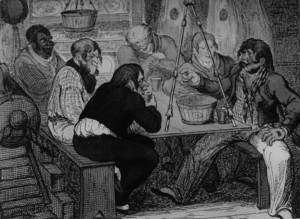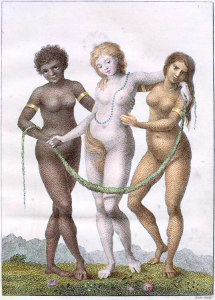Linebaugh, Peter and Marcus Rediker. 2000. The Many-Headed Hydra: Sailors, Slaves, Commoners, and the Hidden History of the Revolutionary Atlantic. Boston: Beacon Press.
 Peter Linebaugh and Marcus Rediker’s groundbreaking book uncovers the history of the many Motley Crews—the many-headed hydras—across the Atlantic Ocean that forcefully fought against the building of state, empire, and capitalism. The Atlantic’s circular winds and currents not only propelled the movement of commodities and ships; they also moved (and instigated) rebels, non-conformists and consciousness as well as ideas and lived experiences of more just and equitable ways of life. Slaves, sailors, pirates, religious heretics and liberationists, “witches,” prostitutes, workers, and servants are the motley, multiethnic lots, who against all odds have sustained the ebb and flow, the crests of revolution and resistance across the Atlantic. Africa, the Americas, and Europe are brought to life through the radical political connections made through these “planetary currents of humanity” (6).
Peter Linebaugh and Marcus Rediker’s groundbreaking book uncovers the history of the many Motley Crews—the many-headed hydras—across the Atlantic Ocean that forcefully fought against the building of state, empire, and capitalism. The Atlantic’s circular winds and currents not only propelled the movement of commodities and ships; they also moved (and instigated) rebels, non-conformists and consciousness as well as ideas and lived experiences of more just and equitable ways of life. Slaves, sailors, pirates, religious heretics and liberationists, “witches,” prostitutes, workers, and servants are the motley, multiethnic lots, who against all odds have sustained the ebb and flow, the crests of revolution and resistance across the Atlantic. Africa, the Americas, and Europe are brought to life through the radical political connections made through these “planetary currents of humanity” (6).
Particularly in light of this blog’s themes, the word motley is worth elaborating:
The “motley” was a multicolored garment, often a cap, worn by a jester who was permitted by the king to make jokes, even to tell the truth, to power. As an insignium, the motley brought carnivalesque expectations of disorder and subversion, a little letting-off of steam. By extension, motely could also refer to a colorful assemblage, such as a crowd whose tatterdemalion dress made it interesting. A motley crowd might very likely be one in rags, or a “lumpen” -proletariat (from the German word for rags). (28)
In their repeated references to Motley Crews (and their multiethnic composition) the authors evoke both meanings: “the subversion of power and the poverty in appearance” (28).
The first connections drawn by Linebaugh and Rediker relate to a series of expropriations—from the first wave of English enclosures, to the colonial system—which helped lay the conditions and possibilities for the consolidating “nodes of the Atlantic nautical networks” (47).
So, it turns out Francis Bacon was a real dirt bag. His writings stitched together a theory of “monstrosity” whose logical outcome was a campaign of genocide. The monstrous was specifically tagged onto the following seven groups: Caliban (or Amerindians), the Canaanite (any dispossessed commoner), pirates, land rovers (petty thieves or bandits), assassins (killers of authority figures), Amazons (militant women), and finally Anabaptists (who were seen as proto-liberation theologians). In broad strokes, Bacon had identified the hydra’s many heads. Indeed, the many-headed hydra is not a creative rhetorical flourish invented by Linebaugh and Rediker; the historical record shows that these groups were repeatedly named in this way, conjuring their accused inhumanity.
The authors conclude the book reviewing their periodizations across two and half centuries of the hydra’s slithery sites of struggle: “the commons, the plantation, the ship, the factory” (327). In the first phase, commoners are expropriated ocean-wide with the help of the ship and terror; the commoners, of course, did not go quietly. Afterwards, the hydra stoked revolution in the metropole, while the plantation system and slavery became the foundation of Atlantic capitalism, despite slave uprisings and abolitionist movements. Atlantic exploitation became further consolidated in a third phase through the maritime state in which the ship itself combined aspects of the factory and the prison. Sailors and pirates built their own autonomous, multiracial, multinational, democratic micro-societies aboard their ships and communities with ensuing rebellions ocean-wide, opening the way for full-form revolutions in the U.S. and Haiti.
The rearing of the hydra’s heads, among other things, “illustrated the transatlantic circulation of experience and the effect of struggles in Africa/America upon social and political developments in Europe, and all expressed an egalitarian, multiethnic conception of humanity” (333). Struggles in Europe, particularly those of the Irish (the “Green Atlantic”), also had transoceanic ripples.
As I had suspected, the most interesting chapter for me turned out to be number five: “Hydrarchy: Sailors, Pirates, and the Maritime State.” The authors show how the ship became “ both an engine of capitalism in the wake of the bourgeois revolution in England and a setting of resistance, a place to which and in which the ideas and practices of revolutionaries … re-formed, circulated, and persisted” (144-145). They call the ship a “machine of empire” but also “a forcing house of internationalism” (150-151).
Proletarians of the deep were particularly hard to recruit, partly due to the subhuman conditions on board and the unlikelihood of ever seeing a paycheck. Sailors and pirates were by default already social outcasts of their own societies—“outcasts of all nations” (158). Marronage was common: “These communities combine the experiences of peasant rebels, demobilized soldiers, dispossessed smallholders, unemployed workers, and others from several nations and cultures” (158). “Therefore when sailors encountered the deadly conditions of life at sea … they had an alternative social order within living memory. Some sailors mutinied and seized control of their own vessels, stitching the skull and crossbones onto a black flag and declaring war on the world” (160).
Pirate ships were democratic (162), justice-seeking, and class-conscious; they were moving examples of workers who had seized the means of maritime production (163). Multiethnic and already the enemy of all nations with no country, they were consummate cosmopolitans. “Indeed, pirate ships might be considered multiracial maroon communities, in which rebels used the high seas as others used mountains and the jungles” (167). Having once been para-statal agents, contracted by own country to attack the commerce of another, pirates eventually became the enemy of all—in large part due to their incompatibility with slave capital and the plantation economy. “[European rulers] discovered common interests in n orderly Atlantic system of capitalism, in which trade would flow without attack and capital accumulate without disruption” (172).


Pingback: Geographies of the Outlaw | Territorial Masquerades